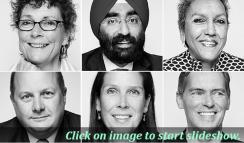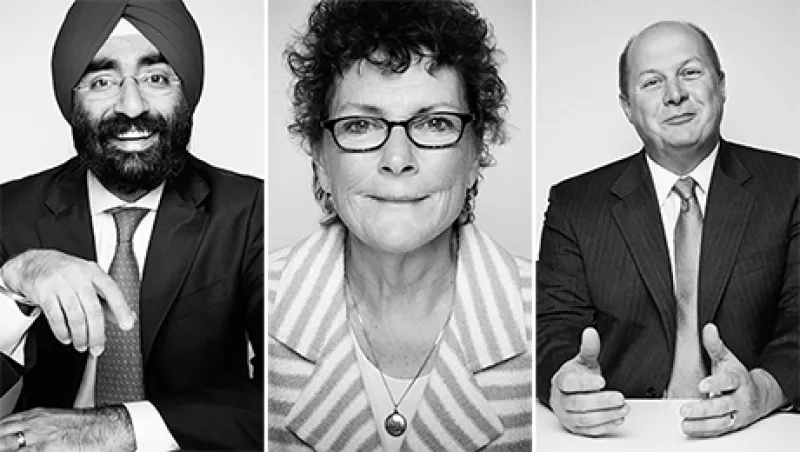On May 15, nine distinguished investors from public and corporate pension funds, endowments and foundations across the U.S. gathered for a closed-door meeting in New York. All were in a celebratory mood the morning after Institutional Investor’s annual U.S. Investment Management Awards dinner, held at Manhattan’s Mandarin Oriental hotel.
Spirits were high as the guests arrived at the Union League Club to tackle knotty questions over breakfast. The menu of topics included issues like how to prepare for an interest rate hike and managing stakeholder expectations, but the overriding theme of the morning was collaboration: a new and growing movement among investors to pool their knowledge, coinvest and form deep relationships.
“Shouldn’t we think about changing the way that we invest?” asked Greg Williamson, recently appointed chief investment officer of the American Red Cross after serving as CIO at BP America, where he managed $10 billion in retirement and foundation assets for the British oil and gas giant’s U.S. operations.
The roundtable participants oversee funds that range in size from the very large — the University of California Regents’ $100 billion, managed by CIO Jagdeep Singh Bachher, a former Alberta Investment Management Corp. executive vice president — to the relatively tiny: the $300 million, New York–based F.B. Heron Foundation, represented by board member Anne Wade, who initiated a lively exchange on impact investing.
Also in attendance were Mark Schmid, now in his sixth year as chief investment officer for the University of Chicago and its $7.5 billion endowment fund, following similar roles at the pension funds of industrial giants Boeing Co. and DaimlerChrysler; Jason Matz, CIO of Carleton College, a 2,000-student liberal arts school in Northfield, Minnesota, with an $800 million endowment; and Fadi BouSamra, CIO for the Metropolitan Government of Nashville, which has a $2.8 billion pension fund.
Other roundtable participants included CIO Marie Pillai, who oversees both defined benefit and defined contribution plans for Minneapolis-based food company General Mills, with a total of $10 billion in assets; Shawn Wischmeier, CIO for the Margaret A. Cargill Philanthropies, a collection of three foundations with $7 billion in total assets (and the third 2015 roundtable participant from Minnesota); and Sandra Urie, chairman and chief executive of Cambridge Associates, who has been guiding endowment, foundation and other investors at the Boston-based consulting firm since 1985.
An edited version of the 90-minute conversation follows.
Institutional Investor: We’ve been in a zero-interest-rate environment for years now. How big a challenge is that, and how do you overcome it?
Marie Pillai: From a pension plan standpoint, the biggest effect that we see is liabilities are going up. You still have an active population, you need to have risk-bearing assets, and so you just hang tight and take some hit to the funded status. Over time we stick with the program and rebalance. It hits the liability on the asset side, but the value of your bonds has gone up quite significantly as well.
Mark Schmid: One of the things that’s impacted us as we look forward at the endowment is expected returns. Our returns have been about 13 percent since the crisis, and everybody loves that. They think if you’ve gotten 13 percent in the past six years, you can get 13 in the next ten. We grapple with this every day, and we’ve gotten them down to 7 or 7.5 percent as expected returns.
Sandra Urie: You bring up a good point, which is managing the expectations of the stakeholders that are involved. There are multiple stakeholders in both the pension world as well as in the endowment world. Investors have been challenged by this low-return environment, but they should remember they have also benefited significantly from high-return environments. These excess returns earned in the high-return environments are the buffer to sustain them during low-return times.
Fadi BouSamra: I think to a certain extent in that kind of environment you have to accept it. There are certain things you’re not going to be able to do. You have to take what the world’s giving you. We do that. We start with how do we manage the overall risk in the portfolio to where we’re going to avoid drawdowns within the construct of the risk that we’re supposed to be taking.
You want to be managing to the risk at this point more than the return because we’ve had really good returns and interest rates are going to turn at some point. And even if they stay where they are, we’re not going to get a lot more juice out of the bonds.
Shawn Wischmeier: A lot of people misunderstand the nature of interest rates. Not everybody, but many, many people have been very short-duration. I do believe interest rates are going up over time. I can’t tell you when or how or why. But it’s not whether or not they go up, it’s whether or not they go up relative to the forward curve. And a lot of people are shortening up. Whereas if interest rates follow the general path of the forward curve, then that’s fine. You might as well pick up a little bit of return by being further out.
There are some strategies to benefit from the general nature of it without trying to time when or how it’s going to occur. We’ve put an overlay onto our portfolio whereby we’re playing a curve flattener, and the goal there is, I can’t tell you when interest rates are going up, so let’s not try to predict it. We do believe when they go up, the front end of the curve is going to come up faster than the back end of the curve. So you’re going to get a shift up, but you’re also going to get a flattening. We benefited healthily on that over about the past year, as some of that’s played out.
More from the roundtable on investing in today's markets:

Is there any benefit in trying to develop a view on where interest rates are going or in incorporating a macro view into what you do?
BouSamra: I think so. Not necessarily because you think your prediction’s better than anybody else’s, but so that you can understand how you’re positioned in that environment and different environments. In the same way that you can’t predict the next recession or the next financial crisis, you want to know how your portfolio is going to react in those.
Urie: Are you stress-testing different scenarios?
BouSamra: Yes.
Schmid: When we do our ten-year expected returns, we do it in four regimes. We do it in a normal regime, where you go back to normality over three years, and then we do a deflationary, and then we do an innovation and we do a stagflation. And then we probability-weight those four and come up with an optimal portfolio that can perform in that environment.
Pillai: Do you make significant changes?
Schmid: We don’t, actually. Not much has changed. If we got to the environment where we have material change in interest rates or valuations, it might have more impact.
Jason Matz: We don’t have a view on interest rates. We’ve been talking about rates being low for over five years and wanting to borrow as much as we could five years ago, and we’re still having those same conversations today. There’s just much more downside risk in the fixed-income market than upside, so it’s very asymmetric. The thing that we worry about is how a rise in rates or a shock to rates would affect equity valuations, which is the dominant risk in our portfolio.
Pillai: Our CFO asks me similar questions: Do we have a view on rates, and how do we position the portfolio? The short answer is we don’t have a view on rates, and we don’t know that we would be able to do that well. We look at things from a strategic standpoint and a relative valuation and just rebalance in a disciplined manner, and that does quite well. We’ve been in long-duration bonds ever since we started. This is where we’ve generated 9 and 10 percent compound returns over 30 years. The purpose of that was to hedge the liability, not to get return. We ended up getting both the liability hedge as well as the return kicker.
Matz: For the endowment or foundation investors, not pensions, have you decreased your fixed-income exposure? We have, materially.
Schmid: We have positioned our strategy in a more conservative manner compared to our large peers due to the university’s balance-sheet structure. Currently, we’ve slightly reduced our fixed income due to the expected rising-interest-rate environment.
You’re trying to lock in low rates?
Schmid: Yes. My biggest fear is that the rates that we’re borrowing at today are not really low.
Matz: Are you borrowing in the taxable market or the tax-exempt?
Schmid: Both. They’re doing a fine job rebuilding the university and making it amazing. But my biggest fear is the Japan scenario from years ago: that we’re not going to get out of this zero interest rate.
Matz: We talk about that a lot at our committee level and try to educate the rest of the board because people do tend to extrapolate what happened in the recent past. And there’s no magical way to generate returns if they just aren’t there. At the same time, I’ve been doing this for 11 years, and I’ve heard it being a low-return environment consistently the whole time. It’s been an uncertain path.
BouSamra: Part of the problem is that historically we don’t have a lot of experience in these low-interest-rate environments. I think it’s worth noting that while there’s certainly a lot of savings in the world chasing safe and liquid assets, the liquidity premium is getting wider on some of these assets.
We decreased our bond allocation significantly below what a typical pension plan has. I think right now we’re at 13 percent. We have 18 percent in what we call fixed-income alternatives, where you have equity and credit risk primarily but you have much-shorter-duration assets with maybe modest leverage. And the idea here is to compound the money at a fast rate and rely more on your and your managers’ credit expertise, as opposed to the liquid bond markets, to create a differentiated rate of return.
Greg Williamson: The central bank activities around the globe are focused on pushing people into risky assets and out of low-yielding fixed-income assets. As investors we have to recognize that there is going to be no return from cash for quite a while. And if the goal is to push people into the risky assets, we should not be fighting the mass of noncash that is going to be moving into those risky assets; we should be participating.
What we’re doing when we talk about risk management is we’re managing the distribution characteristics of our portfolio. What we want are right tails, and we want to cut off the left tails. So we think about the world slightly differently now. We think about it in option terms as opposed to normal distribution terms. How we build optionality in our portfolio is the challenge we face in managing assets.
We don’t know which investments will pay off successfully, but we know that we can take a bet, minimize the downside of that bet through an options platform, and if it pays off, we win over the long term. And we then will have a chance of meeting our objectives.
You have to think about your portfolio as a proprietary trading desk thinks of its portfolio. That is, I have a position, it has a certain P&L associated with it, and market conditions have changed. I have to manage that position relative to what somebody will pay me for the liquidity I provide to the marketplace. I might have to trade around a position like that. I hate the fact that as long-term investors we have to be traders, but in this market you have to manage your risk in a trading-oriented fashion as opposed to a buy-and-hold fashion.
Matz: We’ve talked a lot about hedging, too, over the past few years and decided not to do it because of the cost of purchasing insurance. I’m not so sure I agree with moving away from a buy-and-hold strategy, but as we manage risk, one of the things that we’ve done is raise a little bit more cash than we would otherwise have, and that is a form of hedging. We want to keep our financial flexibility in the event that markets do go down, and have cash available to invest.
BouSamra: That brings up a great point. I’m curious about what all of you are doing, especially some of you who have been doing this for a while, about the idea of creating a portfolio where you can alter your capacity for risk in given environments. Instead of having a 50 percent static allocation to equities, create a situation where you have a flexible allocation to equities targeting a certain level of volatility.
Matz: Yes, we are. It’s a very weighty decision to move away from your policy portfolio. We developed a policy portfolio that if we leave it untouched and we execute well, we’ll satisfy our return objectives over a very long period of time. We’re an endowment, so it’s a perpetual horizon. I think a lot of people lose that focus. We are having an active dialogue now about moving away from that policy portfolio to underweight equities.
Jagdeep Singh Bachher: How many folks are managing money in-house versus externally? Is it all done externally through managers?
Pillai: For us it’s almost all external, except for our internal tactical asset allocation model, for which we use futures.
Schmid: The predominant model, whether it be a large pension or big endowment, is the external model, the model of picking the best managers. We’ve got some Treasuries and [Treasury Inflation-Protected Securities] in-house, but it’s an external management model.
Matz: We’re the same. Except for our futures exposure that we use to rebalance the portfolio, it’s all externally managed.
Williamson: We have a combination.
Bachher: We have about $35 billion in fixed income that’s primarily managed internally. The benefit we have is because of our size and scale at $100 billion [in total assets]. I like having cash because when you’re in this lower-return environment there will be buying opportunities in riskier assets, so it’s nice to have the dry powder to be able to act decisively and have your shopping list ready. In the past year we’ve been building up our cash in all of our portfolios at about 3 to 5 percent.
How is the University of California’s pension fund faring?
Bachher: The pension plan is about 87 percent funded, with contributions reinstated in 2010 after a 20-year holiday. Just yesterday there was an announcement that close to $500 million will come from the state into the pension plan.
Have you seen any buying opportunities recently?
Bachher: I don’t see the buying opportunities as trying to compete with all the other funds out there. We’re thinking about them in light of the competitive advantages of being the University of California — where we’re located and the ten campuses and five medical centers and three national labs and so on. I can tell you this much: Just in the past year of opening up the doors and letting people know we’re open for business, we’ve done close to a billion dollars in public and private transactions.
Matz: Are these co-investments with your managers or direct deals that you are doing on your own?
Bachher: If you can, look for the most efficient way to access a transaction that’s aligned with your interests. For example, we bought the building [in Oakland, California] we work in. We have a very large network around us that we can learn from or capitalize on and bring to our advantage.
Urie: And is this bringing some of the Canadian experience to California?
Bachher: The Canadian experience is about good governance and having a professional organization. In this low-return environment, we have to pay attention to cost. When you access investments directly, you think you’re getting a cheaper deal, but ultimately you build a very large organization.
BouSamra: Sometimes our governance models take some key options and strategies off the table; when you’re not managing internally or you don’t have the staff, you have to take some things off the table. Sounds like you have quite a few things on the table.
Matz: That’s where scale is a significant advantage.
Bachher: If you can use it as an advantage, it helps. We manage an $8 billion endowment with the benefit of a $100 billion checkbook behind us, so we can do a transaction for the endowment and have a meaningful partnership and a relationship with everything else. On the flip side, we have ten foundations at the University of California that are growing into either their own management companies or their own governing bodies with investment committees. I’ve said to all of them, “You’re all different, multisize, billion-dollar endowments, but you should think about it this way: We should collaborate with each other to invest in opportunities.”
If they do a $25 million or a $50 million deal, they may call me and ask, “If we can potentially do a $250 million to $500 million deal, are you in for the rest?” “If it’s your best deal,” I’ve said, “yes.” So leveraging is not a disadvantage. Because the one thing I keep hearing from everyone is it’s very hard to manage large pools of money. In the Canadian model everything is a large pool of money, so you have to quickly learn how to leverage your size and scale to your advantage, not your disadvantage.
BouSamra: In the U.S. we tend to look at managers’ fees as a cost and internal staff as a cost. When you look at the Canadian plans and the California plan, co-investments are a differentiating advantage. From a governance standpoint we have to start thinking about “Is this an advantage we can play that we can have the internal resources to do things so we can take less risk, achieve higher returns and do it at a much lower cost?” The mentality is not quite there yet for most plans. Most people think of it as just a cost. That’s probably going to change. The results are very good for those plans that have been able to make that leap.
Williamson: Shouldn’t we think about changing the way that we invest? Given the size of assets that Jagdeep is looking at, should some of the smaller organizations create consortiums, their own internal portfolios, to combine assets and think about private opportunities or economies of scale with larger investments and realize the strengths of an aggregated approach as opposed to an individual approach to portfolio management?
In Chicago a group of CIOs — Mark and I were part of it — would get together to discuss investment strategies. One discussion centered on building our own private equity platform, with investments funded by our combined capital. We ultimately decided not to do it, but it’s the type of investment structure that institutional investors need to consider.
Matz: That’s a fantastic idea and something that I’ve thought about for a long time. I think it’s almost unrealistic, unfortunately. Because you’ve got different pools of capital, different investment committees, everybody’s got an emotional attachment to their portfolio, likes to make their own decisions, and everybody thinks they’re above average.
Wischmeier: It’s a great idea, but I agree with Jason — it generally doesn’t work. It’s not only because of committees, but then you need somebody to run it. Somebody emerges and what you find is suddenly I’m charging 1.5 [percent management fee] and 20 [percent performance fee] to run it. And you get all these same structural problems. I wish it would work. I really do.
Urie: Over 30 years I’ve seen particularly smaller endowments trying to figure out how to get the scale to do what the larger endowments can do.
Pillai: Speaking of consolidating assets, you can do it at different levels. In our plan — I think I’m the only corporate here — what we do is we consolidate: We use the same managers across our DB and our DC plans. Our DB plan is much larger than our DC plan. We provide private-label options on the 401(k), and we package the managers we have on the DB side into large cap, small cap, whatever it is. That’s how we get the scale economies, which the DC participants can get advantage from.
BouSamra: What is more realistic? I’m in a city where I’m fortunate to have the Vanderbilt University endowment and the Tennessee Consolidated Retirement System. We share ideas about management approaches and other issues. While technically we don’t go into the same product, we have some similar managers. That could potentially grow.
Wischmeier: I agree with Fadi. You can create it by calling around individual deals. We create negotiating leverage and get terms we want.
Matz: Sandy, have you seen anybody get together like that, smaller institutions? Or have they just talked about it over the years?
Urie: It bumps up against this issue of control and governance at the individual institution level and the fiduciary role that the people on the board play in giving up and handing over. But we’ve certainly seen in the outsourced CIO movement the willingness to outsource and to hand over fiduciary responsibility to an outside party.
Matz: If you have a consortium of smaller pools of capital together, why should it be different from an outsourced CIO?
Williamson: As Shawn points out, there are formal and informal ways to build consortiums. The consortium that I talked about in Chicago was a more formal way, but we’ve done a number of deals over the years where we found a good investment opportunity but it was too large or it didn’t fit the right risk profile for us. We went out to people that we knew would be interested in it and brought them in. Now, we didn’t do it as a partnership, but by combining interests we were able to actually conclude the transaction, get the piece that we wanted and the opportunity to scale. There are a number of different ways to think about how smart people can work together to create solutions.
Anne Wade: Sandy, as you know, it’s extremely common for mission investors to see an opportunity where you think there’s going to be a good financial return and perhaps more importantly there’s a real social impact to be had. Everybody calls everybody they know to try to pool the biggest amount of money. One of the things that the mission side has done a really interesting job with is putting together quite complicated capital stacks for an organization or a project that needs funding from a variety of different layers in the stack. Some of the mission investors will take the piece of it that’s the most mission-oriented — and sometimes that means that they’re going to take a bigger piece of the risk. There’s a big part of this that looks like just a traditional debt deal.
Urie: They’ll do it as a PRI [program-related investment]; that’s part of the stacking. That’s part of the design that the foundation will make, because the PRI can be credited against the spending.
Wade: One of Heron’s advantages in having completely consolidated our mission and financial side is the ability when an organization comes and is looking for capital, we’re in a position to say, “What it looks like you need is a grant to solidify your balance sheet, to attract the next level of capital.” So we do it as an equity enterprise grant in which we structure it very much as an equity injection but the returns accrue entirely to them, as a way of solidifying that balance sheet so they can go to some of you guys and say, “Now we need something that looks more like a market return vehicle with a stronger capital base.”
Bachher: I encourage all of you to open your minds to the idea of collaboration over the next five years, because, as leaders in our space, it is going to be one of the important trends that can’t be ignored. I am a very big believer in collaboration, and I’ll tell you what the problem is.
The demand from pension funds for alternative assets is starting to outstrip what the endowments can put money to work in. If that’s all there was in the world, maybe we could say, “Yes, we can deal with this issue.” But somehow in the past decade we now have 8,000 hedge funds, 5,000 private equity funds, more private equity than publicly traded companies. The opportunity set is growing significantly.
In the past decade the other trend is the growth of sovereign wealth funds, which are about $8 trillion in total. These funds are starting with a clean piece of paper. They’re going anywhere around the world to figure out what the best practices are and looking at the U.S. endowment model and the Canadian model, and they’re replicating it and improving on it instantaneously.
How does that lead to collaboration?
Bachher: The rest of the world has started to figure out ways to collaborate. There are many models. Outside of the U.S. partnering is becoming much more the norm. It’s difficult, but there are ways to do it. It’s not about making clubs. It is deep, one-to-one relationships. It becomes knowledge sharing at an organizational level, at a talent level.
Schmid: My chief risk officer, Mike Edleson, told me earlier this week that he’s done 28 benchmarking sessions in the past eight, nine months with sovereign wealth funds, pension funds, endowments and foundations. I knew he was doing it, but I had no idea he had 28 calls or meetings in eight or nine months.
Urie: You’re seeing it in the move to co-investment and direct investment. All of a sudden, in the past several years, everybody is looking for ways to lower cost and increase returns. It’s coming from very, very large investors. Now everybody seems to want to do it as well.
Going back to what Anne was saying, is there a correlation between financial performance and social responsibility?
Wade: One of the most surprising things that we at Heron run into is a fundamental belief that to invest with a social conscience is to accept lower returns. When I look at our own investments, they look like other types of investments. You get some right, and you get some wrong.
We would make the case that over the longer term social impact is financially important for two reasons. It supports the health of a company quite directly by positively investing in the communities in which it operates. There’s also a virtuous economic cycle of promoting a thriving economy by trying to do the right thing. Over the longer term the two should be very positively correlated. Over the shorter term, as with any number of investment asset classes, there are some fantastic deals out there that offer great financial return along with a social impact, as well as those that disappoint.
Matz: The market view is any time you reduce the available investments, it automatically reduces your return.
Wade: Because you’ve narrowed the field.
Matz: Yes, you’ve reduced the amount of decisions you can make. I’m not saying that’s accurate, but I’m saying that’s where it comes from.
BouSamra: Anne, you view it more as a positive, proactive mission to go out and make investments with that idea in mind. For public pensions, unfortunately, many times socially responsible investing means eliminating some of the options instead of proactively making investments that could lead to positive outcomes.
Wade: Right. There are any number of organizations that try to invest the same way that Heron does, but we do it on a positive impact basis. One of the shortcomings that I see in the carbon-divestiture conversation is that it is around the pulling out of assets, when that feels like half an investment thesis to me. The conversation should be about the redeployment of those assets into positive sources of transitioning our economy. Even if they want to transition — even if what they want is a transition away from carbon — we are a carbon-dependent economy at this point. Most universities still require carbon intensity to keep their own lights on.
I loved Jagdeep’s example of buying the building in Oakland. I love the idea of a big university making a positive investment in the physical and social capital of the environment in which the university sits. That’s a fantastic use of endowment money in terms of creating that cycle. There’s a positive return there, but there is a benefit to the community and a benefit to the university.
Bachher: As leaders we can’t ignore environmental, social and governance issues, and we’re confronted with them in various forms every single day. So whether it’s divestment from fossil fuels or it’s income inequality, you pick up the paper and there’s something you have to deal with.
I try to stay very focused on the fact that we have a fiduciary responsibility. We’ve got to meet various obligations. As part of earning return, you have to manage risk, and risks evolve, especially for long-term investors. We’re taking this as more of a framework and saying we have to embed it in the way we think about our investments instead of keeping the conversation separate about a social return versus an economic return.
Urie: But it does have to incorporate the positive aspects of it. It shouldn’t just be about divestment. And I think the current debate has become very adversarial. In fact, there are good things happening. There’s great research going on at these universities in terms of alternative energy sources. So the money that’s being earned in these endowments is being invested in great research. We’ve got to focus on that as well.
Bachher: As investors in real assets that invest in traditional oil and gas assets, we need to start thinking about new energy as well as including renewables. We’ve committed over the next five years a billion dollars toward the new energy solutions as part of the conversation on the positive side, to invest in climate solutions.
Urie: We have a database which has 70,000 portfolio companies in it from the private and venture space, and a team at our firm went through it. They identified the underlying cleantech companies, unbundled those partnerships and created a cleantech index. When you’re making investments like that, you can say, “This is how we are doing relative to the industry, to a benchmark.” It’s a benchmarking capability.
Wade: In the impact investment space, a significant amount of the conversation ends up being more environmental because it’s easier to measure. It’s much harder on the social side, where there are fewer data points that can be counted. At Heron we believe when you look at what has happened economically and as a result socially since the financial crisis — the increasing economic inequality — there’s a legitimate economic reason to focus on that. The rising levels of inequality, the rising levels of poverty in the U.S. pose longer-term concerns to the kind of economic growth that we all hope to benefit from in the U.S.
Wischmeier: Mission-related considerations are a key part of our process. We’re looking at all prospective alternative investments. It gets back to the comment about asking questions. We’ve had managers that we’ve been in diligence on, and we asked, “Do you have an ESG policy?” Their response was, “What’s ESG?” It gives you a lot of insight. It’s one thing if they might or might not have a policy, but if they’re unaware of what’s going on in the marketplace, that’s very telling.
We’ve gotten probably more leverage or impact through those questions and those focuses. We’ve had four or five different managers write policies about how they’re going to add ESG factors. I can’t measure the impact of that, but I look at it and believe that on a magnitude basis that’s probably having more effect broadly than some of our small investments and mission-related investments.
Matz: We don’t give managers the benefit of the doubt, because they do think about these issues. There is no manager we have that doesn’t think about the governance at a company, doesn’t think about the company’s environmental and social impact. These are things you need to know because they affect the prospective return of any given company.
Wade: I love what you just said, because ultimately all investment is impact investment. The question is, Has an investment been analyzed for impact and is it making a positive impact or a negative impact? •
Visit Frances Denmark’s blog and follow her on Twitter at @francesdenmark.






